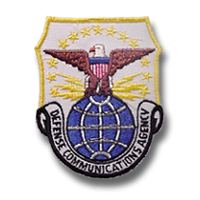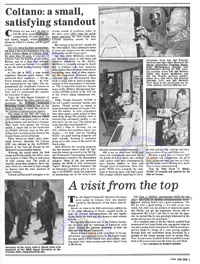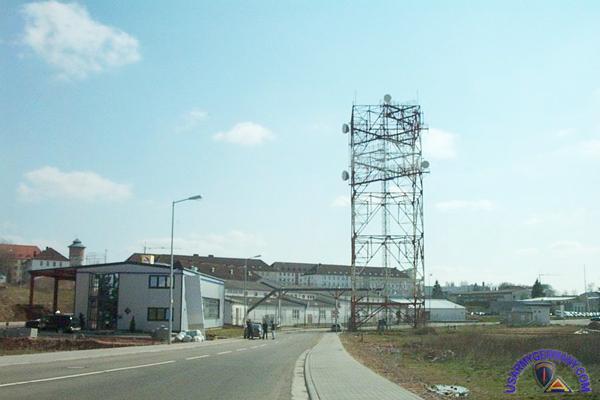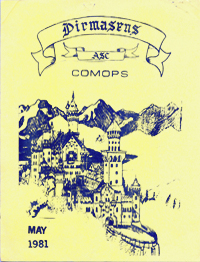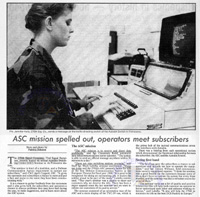| If you do
NOT see the Table of Contents frame to the left of this page, then
Click here to open 'USArmyGermany' frameset |
||||||||||||||||||
Automatic Digital Network (AUTODIN) |
||||||||||||||||||
|
|
||||||||||||||||||
|
||||||||||||||||||
|
|
||||||||||||||||||
| Communications Logistics Network (US Army) | ||||||||||||||||||
| Air Force Data Communications Network (US Air Force) | ||||||||||||||||||
| (Source: STATS & STRIPES, March 1, 1963) | ||||||||||||||||||
| The AF DATACOM Network, according to the S&S article the world's largest and most advanced data communications network, was activated at Andrews AFB on Feb 27, 1963. Upon activation, the system became the first increment of the Dept. of Defense automatic digital network (AUTODIN). The new system links some 300 Air Force, DoD and Defense industry users into a common system for the rapid interchange of vital communications. The heart of the network comprises five automatic switches: Tributary stations can be linked to one another or to any group of stations through the automatic switching centers. Several actions are underway in the European-African-Middle Eastern (EAME) Communications Area (Brig Gen George M. Higginson is Cmdr) to extend AUTODIN into Europe: |
||||||||||||||||||
| AUTODIN 1960s-1990s | ||||||||||||||||||
| 1966 | ||||||||||||||||||
| (Source: Email from Tony Kubiris) | ||||||||||||||||||
| Subject: DA & & the data transmitted via the Autodin System, 1966-67 This is in response to the following request: If anyone has more details on this system and on the USAREUR Machine Records Units and Signal units (transceiver network) that played a role in delivering corresponding personnel data to the Pentagon, please contact the webmaster. During 1966-67 I was attached to the United States Data Support Command (USADATCOM), TAGO, DA, The Pentagon. We maintained the Army's personnel data base. USADATCOM was broken into 3 sections: 1. DA Systems -- approx 300 programmers, 50% military, 50% civilian, who maintained & provided reports from the two personal data bases (Officer Master Tape Record, OMTR & the Enlisted Master Tape Records EMTR). The OMTR was approx. 2,300 characters long while the EMTR was approx. 1,600 characters. The computer inventory at the start of my tour was: IBM 7080, 1410, & 1401 plus numerous IBM key punch & sorting machines. The computer room was located in the Pentagon's basement, room BE-833. The programmers were located in suburban Washington. In addition, USADATCOM maintained files such as the Unit Identifier Codes (UIC) & produced the UIC books for approx 40,000 military locations worldwide. 2. Field Systems Unit who was responsible for writing the code for the data processing machines located at the various Army Level Commands around the world. I my time they were coding mainly for the RCA 301 & 501 machines, although other computer types were in the field. 3. Autodin Unit. This was my unit, located adjacent to the main computer room we were responsible to monitor the regular personnel information sent from the Army level AJ units around the world. We were a small Division, 1 Supervisor (retired O-6), 2 System Analysts (1 civilian & an E-8's slot , 5 Programmers (3 enlisted programmers & 2 civilian), and 3-4 Enlisted Clerks. Data of a particular type was sent on a regular scheduled day of the month in Groups designated by a two letter designation code (EO, EW, OF, OA etc.). They were batched in 500 cards groups, 2 header cards, 496 data cards, and 2 trailer cards. Typically there would be 15 to 40 batches to comprise that month's transmission of any single tow letter code type. If everything went well the error free batches were held until all the batches were received & then they were released as a group to Computer to be run overnight adding the data to either the OMTR or the EMTR. However, typically a good percentage of batches were received faulty. Headers & Trailers didn't match, selective data record were missing the two letter designation code. Any faulty cards were printed on a 80 column sheet showing the data as received. My clerks usually arrived at 0500 hrs. to sift through the faulty records & try to reconstruct the missing data. Often entire data batches were blank causing many boxes of printouts. When the clerks could not fix the problem I & my fellow analyst would have a go at them. If they totally beyond repair we would call the originating Army's Autodin unit & request a retransmission of the failed batches. This process was repeated until either the batche's two letter designation code deadline for insertion into the main database or we had about 98% of the data for that batch successfully received. As an E-3 I was filling an E-8's slot as an one of the 2 Systems Analysts. I had lots of ADP experience prior to enlisting & I impressed the E-6 who held the slot before me with my knowledge & he recommended me as his replacement. After a year, I was reassigned & went to CinCPac Staff in Hawaii for 18 months. I hope this adds to your knowledge database about early uses of the Autodin system from DA point of view. ADDITIONAL INFORMATION I have an funny story to add about my experiences at the Autodin Group at USADATCOM. My predecessor at that unit was Staff Sergeant E-6 Jack Doyle. He had an interesting story about the Pirmasens Autodin unit. This Autodin switch (early 1967-68) seemed to produce more errors that any other in the world. It seems Sgt. Doyle needed about 24 out of 50 batches transmitted because of irreparable errors. Sgt. Doyle got on the Autovon to Germany & spoke with a Sgt. at the Pirmasens Autodin switch and made the re-transmit request. The Pirmasens Sgt. said something like this: "We show that the data in question was shipped correctly; there is no problem". Jack responded: "We didn't receive them in a usable form, please re-transmit them". The Pirmasens Sgt. said: "Not our problem; you fix it". Jack responded: "Not possible, you need to re-transmit these batches". The Pirmasens Sgt. asked: "You are a Sgt; what grade are you? Jack responded: "Staff Sgt. E-6". The Pirmasens Sgt. responded: "Well I'm a Master Sgt. E-8, Master Sergeants don't take orders from E-6 Staff Sergeants". Jack responded: "Thank you Sergeant; we will be in touch". Our Officer In Charge (retired O-6) who sat just across the aisle in our small office overheard Jack's side of the conversation & asked , "What's the problem?". After hearing the Jack description of his conversation she picked up the phone & called her boss the CO of USADATCOM (Colonel, O-6). He, in turn, called the Adjutant General, Major General (O-8) who called the senior AG in Europe (I believe was a Brig. Gen, O-7) who, in turn called the Sergeant E-8 in the Pirmasens Autodin unit. The Master Sergeant was told: "When you receive a call from DA you will follow their orders exactly & say, 'Yes Sir', to whomever you are talking to"...."YES SIR" was the response. I was told it was a 30 second phone call. As a footnote, any time I needed re-transmissions from the Pirmasens switch I got one of my lowest ranked clerks (usually an E-3 or E-4) to call Pirmasens & ask for a specific Master Sergeant. Lesson: "Don't mess with anybody from DA, The Pentagon!". Hope you might use this; I'd like to hear from anyone at the Pirmasens switch who heard about this incident. |
||||||||||||||||||
| European Theater AUTODIN Switching Centers | ||||||||||||||||||
| Coltano ASC, Italy | ||||||||||||||||||
| Additional Coltano ASC articles can be found on the 509th Signal Battalion Page. | ||||||||||||||||||
| 1984 | ||||||||||||||||||
| (Source: TOWER ECHO, July 1984) | ||||||||||||||||||
|
||||||||||||||||||
| Pirmasens ASC, Germany | ||||||||||||||||||
| Additional Pirmasens ASC articles can be found on the 73rd Signal Battalion Page. | ||||||||||||||||||
| (Source: Pirmasens AUTODIN website - http://autodin.pirmasens.army.mil/Default.html; now a dead link) | ||||||||||||||||||
| History of the Pirmasens AUTODIN Switching Center By L. West Sunderland The earliest drawings still on site reflect construction being completed in late 1966. The site was turned over by the USAREUR Engineers on January 4th 1967. However, due to some wrangling amongst agencies, the first live traffic didn't pass until early 69. From that birth, the Pirmasens ASC has progressed through a myriad of personnel and hardware changes. Through the more than thirty years and all the changes, the Pirmasens Germany ASC upheld the proud tradition of service provided by the Automatic Digital Network. The mission was important, always completed and always with pride. Over the many years, Pirmasens was often selected as the best in Europe. We often received the European Switch of the year award. When we didn't, we still thought we should have. The following is a brief synopsis of some of the highpoints. Pirmasens originated as an Army O&M responsibility. For the first three to four years maintenance was performed by the installation contractor, "Philco Ford". The operation of the facility was the responsibility of assigned Army Personnel "Green Suiters". The earliest military unit at the local level was STRATCOM Facility Pirmasens (Strategic Communications Command). An oversized battalion of around 800 Army Signal Corps members. Approximately 200 of these personnel were directly involved in running the Pirmasens ASC. In early 1974 STRATCOM Pirmasens was redesignated the 73rd Signal Battalion under the 5th Signal Command. Within the 73rd Signal Battalion, the 270th Signal Company was tasked with operating and maintaining the AUTODIN Switching Center. Our sister company, the 267th Signal Company was tasked with operating and maintaining the Primary Technical Control facility. From that point, although there were many changes in personnel, the unit designation remained constant until the fall of the Berlin Wall and the subsequent draw down of troop strength within Europe. We were passed from hand to hand like an orphan. The 270th Signal Company colors were retired in 1993, the command and control passed on to the 327th Signal Company, 302nd Signal Battalion. The 302nd Signal Battalion was deactivated mid 1994, the command and control passed on to the 181st Signal Company, 43rd Signal Battalion. Early 1994 the Pirmasens AUTODIN underwent a major change of personnel. The fall of the Berlin Wall captured another victim. All military personnel were phased out in the early nineties. The transition to 37 Government Service Civilians for all sections except 5 Civilian Maintenance Personnel and 2 On-site Programming Contractor Personnel was complete in 1994. Our compliment of civilian workers was filled out primarily by transfers from our sister switches around the world. That is our current state today. Still running along nicely. Passing traffic, doing a great job, making very little noise and trying to beat the next cutback. The compliment of personnel consisted of and still does of very highly motivated professionals. A typical compliment of personnel during the rein of the military would have been around 200 military. The "Day Ladies" or straight day workers numbered in the forties. This is excluding the military unit management. On site was an Officer in Charge (OIC) of the site, at first a Lieutenant or Captain. This position later became a senior Warrant Officer position. The assistant or Station Chief was a Sergeant Major position. The major branches were Operations, Communications Security (COMSEC), Maintenance, Special Security Office, Patch and Test, Programming and later the Security /MP Force. Each of these branches had at least one Warrant or Commissioned Officer in Charge and all but two had a Master Sergeant as NCOIC. |
||||||||||||||||||
|
||||||||||||||||||
| The first major change in personnel occurred in June of 1988. Maintenance went from "Green Suit" to being contracted out. CONTEL assumed that maintenance responsibility with the advent of OPS 16. CONTEL later merged with GTE in 1991. After ten successful years the CONTEL/GTE contract was over. SAIC took over the maintenance in December 1996 and is currently conducting the maintenance of the AUTODIN equipment on site. At the same time as Maintenance, the programming shop went contract. The OSP duties have been ably performed by DSA programmers from June 1988 to present. Under the watchful eye of DCA, Operations was performed by U. S. Army AUTODIN experts. It was like a large family. After a while, no matter what AUTODIN Site you went to in the world, you would find someone you knew or heard of from a previous assignment. It is difficult to be brief on a lifetime of work and the dedication of so many, many "AUTODIN FOLKS". So excuse a little bit of nostalgia. What do you remember from the fielding of past OPS changes? Reminisce with us! Remember OPS 5 or 8? The history tapes opening and immediately closing and walking through every tape drive in the house until you couldn't open a history and were down for an hour reload. Parameter tapes? The change out of the drums in 74. Odd and even taps. All the hardware upgrades. All the flux and change and still passing that traffic. AUTODIN is truly a family network. A collection of people and hardware transcending the hopes of its originators. The Pirmasens Automatic Digital Information Switching Center continues to be a proud member of the AUTODIN Family. More AUTODIN History can be obtained from Tino Randall's AUTODIN Summit 2000 Webpage "http://www.pretek.com/autodin/history/history.html" |
||||||||||||||||||
| (Source: ECHO, June 10 1991; Pirmasens ASC Home Page, Nov 1998) | ||||||||||||||||||
| |
||||||||||||||||||
| 1966 - 1968 | ||||||||||||||||||
| (Source: Email from Bill Gilroy , Pirmasens STRATCOM Fac, 1966-68) | ||||||||||||||||||
| I was stationed at the Pirmasens STRATCOM Facility from 01/1966 through 07/1968 as a 72B20, Communication Center Specialist. Although we were a major communications relay station, every message was manually processed using paper tape received from microwave transmissions. At the time of my rotation, AutoDin was still under construction, however buddies of mine still at the facility stated AutoDin went online in 1969. Unfortunately I don’t have any information as to when the relay station ‘officially’ transferred control and processing to AutoDin. Statcom’s Pirmasens communication center was highly secure and compact. The center housed 4 main groups… (1) ‘The floor’ ( (2) microwave, (3) hardware maintenance, and a (4) backup power station. In early 1967, the comm center was fully staffed operating 3 eight hour shifts with approx 75 men and women per shift. At the latter part of 1967, during the buildup of troops in The comm center itself was a major relay station, handling traffic worldwide. All messages were received via paper tape. The incoming messages were segregated, routed, and transmitted within 30 minutes. There were only 2 computers used on the floor -- Univac AMARS and RECALL. AMARS was a computerized message splitter that was used when a message had multiple destinations. The comm center went into a no drill full alert mode four times during my tour from 1/1967 – 7/1968: -- 1st was the result of the midair collision when a B52 and a refueling tanker collided over the coast of -- 2nd was when an Eastern Block fighter pilot defected to the west in his MIG. -- 3rd was when the USS Liberty was attacked by Israeli fighters and torpedo boats, and -- 4th was the TET Offensive. |
||||||||||||||||||
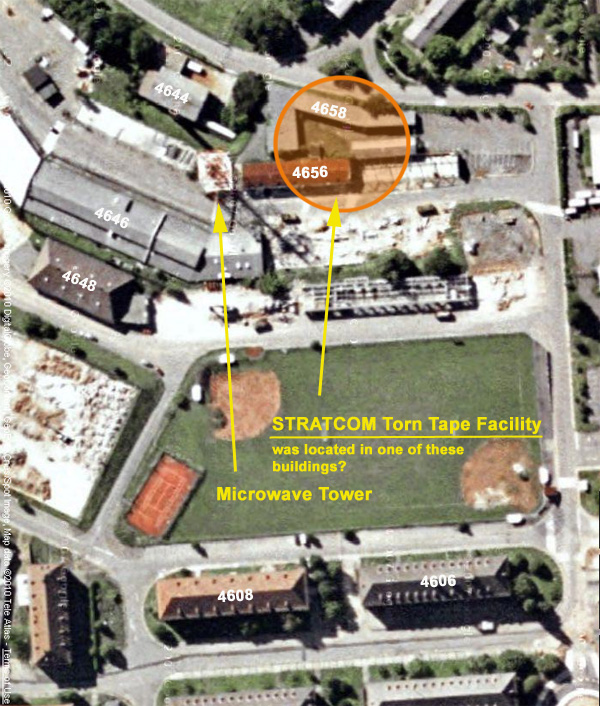 Approximate location of the Pirmasens Torn-Tape Relay facility on Husterhoeh Kaserne (Google Maps) (Please contact me |
||||||||||||||||||
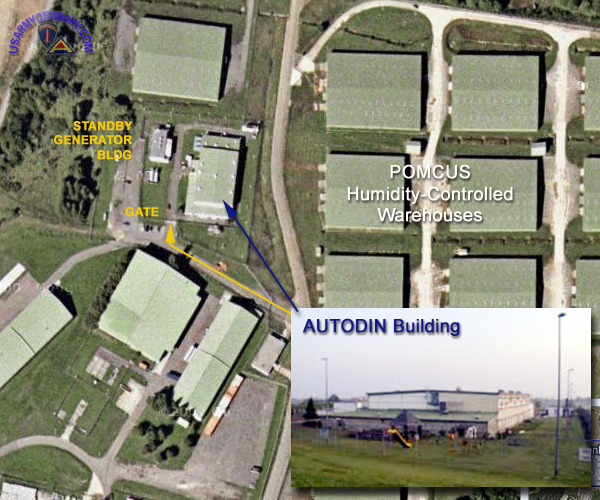 Location of former Pirmasens AUTODIN facility on Husterhoeh Kaserne (Google Maps) (Please contact me |
||||||||||||||||||
| 1968 | ||||||||||||||||||
| (Source: Email from Lyle Jacobsen) | ||||||||||||||||||
| I was stationed at the US Army STRATCOM facility in Pirmasens from Nov. 1968 to Feb. 1970. I was with the 22nd Signal Group and a part of Support Company.
I served as a gate guard at the AUTODIN site for the first month I was there. I then worked at the torn tape relay center for about 6 months until it was closed down and then I was moved to the AUTODIN site as a tech controller. I arrived in Pirmasens as a PFC and left as a SPC 5. I enjoyed my time in Germany and to this day feel privileged to have been a part of such an elite and dedicated unit. My introduction to electronics and communications while in the Army led to a 38-year career in the aviation industry installing and maintaining a variety of navigational and weather reporting facilities. I went to AIT at Fort Mammoth and was trained as a microwave operator and repairman. When I got to Germany I ended up working in the torn tape relay until it closed down. They needed “tape apes” worse that people in the microwave section. The microwave equipment was housed on the fourth floor of our barracks (Bldg #4606) and was later moved to the same building the torn tape relay had been in. They built a new tower that was one of the big four legged towers like ATT had all over the US. I was never in the new microwave facility after it was moved but was in the old one a few times. I did strap some attenuator pads for the new site in my off time for the contractor that was installing the station. One of the installation technicians hired a couple of us GI’s and paid us $1.50 to strap the attenuators. That supplemented the E-4 pay quite well for a couple of weeks until the job was done. I ended up with 3 MOS’s due to being promoted twice while I was at Pirmasens. I arrived as a microwave repairman (26L10). I made E-4 at the torn tape relay and received a Crypto MOS. I made E-5 while at the AUTODIN site and my MOS changed to Tech Controller. I often comment on the Crypto MOS in that I was assigned that MOS and had never seen a piece of Crypto equipment. AUTODIN Yesterday I found a picture of the AUTODIN building on the internet (Bob Bollard's website - insert in sat view of AUTODIN facility Husterhoeh Ksn; see above). The building had an addition on it that looked like a lean-to. It also looked like it had some play ground equipment there as well. In the satellite photo, the bare earth to the left of the antenna farm was the land fill when I was there. One day when I was on duty as the AUTODIN gate guard, I heard some gun shots near the dump. There were some crow in the area and I think someone was trying to shoot a crow or two. Anyway, I heard the rounds zip just a little bite over the top of my head and it really got my attention. I had only been there a couple of weeks at the time. The standby generator was in the building to the left as you indicate. It was a good sized building, too. They were maintained by German National employees who also took care of the heating and cooling for the AUTODIN building I believe. I know the German Nationals looked at the chillers etc. because I had an encounter with one of them during my time as a gate guard. My orders were to call for an escort for him and he wanted to go inside the fence to the chillers unescorted. He acted like he couldn’t understand English until I grabbed the M14 I had at the gate shack. He actually could speek pretty good English once I had the weapon in my hands and yelled halt. The standby generator (there may have been more than one) would generate 220 VAC 50 cycle power. AUTODIN operated on 120/240 AC 60 cycle. The 220 VAC 50 cycle that supplied the site was rectified and this DC operated alternators with output of 120/240 VAC 60 cycle. I believe there were 2 alternators on line backed up by 3 spares. There was also a bank of glass batteries like those used by the telephone companies at that time located in a room adjacent to the room that housed the alternators. They stored enough energy to keep the alternators operating for about 15 minute until the standby generator could be brought on line. The only way you knew that the site had gone on standby was that the emergency lighting in the site would come on and all the fluorescents would go off. |
||||||||||||||||||
|
||||||||||||||||||
TORN TAPE RELAY The torn tape relay and primary tech control were part of STRATCOM Support Company. I think the microwave site was attached to Support Company during the time I was there. We were also part of the 22nd Signal Group. |
||||||||||||||||||
| 1969 | ||||||||||||||||||
| (Source: Email from Norm Roberts, 1969-1971) | ||||||||||||||||||
| I was stationed at the US Army STRATCOM facility from June 1969 to March 1971. I was a Technical Controller in the AUTODIN site. I worked on the same shift in AUTODIN Tech Control with Lyle Jacobsen (see Lyle's email above). I'm trying to think of a way to express my memories of this. It was a terribly frustrating job. The clipboards that were hanging above the circuit alarm panels probably carried my knuckle prints for some time after I left. The lights would pulse red until acknowledged and then after a few minutes of continued outage, would return to pulsing. It triggered a visceral anger response. Happily no government property was actually damaged and my hands still work. We used teletype (tty) 'order wires' to communicate with the main regular tech control site and a couple of other sites. One weekend, during an unusual slack period I sweet talked a number of sites into patching a bootleg series of TTY communication links to a Navy site in Hawaii where a friend of mine worked. Lots of noise, but it was workable. He was somewhat surprised. My handle was CD, which became Crazy Dog. You could make those old teletypes into very expressive modes of communication... ringing bells and making the carriage jump between upper and lower case. One thing we had to do was burn classified waste (it was all classified, even if it wasn't). There was an incinerator out back. We would haul the giant canvas bags of shredded paper to the incinerator and feed it. On a hot day this was a truly horrible duty. I was just glad it wasn't Vietnam and we weren't burning human waste. After it was all burned the incinerator was cleaned out of all the ash (making sure everything was burned) and an officer was summoned to check the burn bags and the incinerator. One sunny morning while waiting for our little bus to transport us to work a colonel drove by in a staff car. There were maybe 12 of us standing there, unaware of the situation. The staff car came to a tire squealing stop and a red-faced, angry colonel erupted from the car. No one had saluted. He started toward us and one of the guys stepped forward and saluted him and said "Good morning, Sir!" "Who is in charge of this formation?" the colonel yelled, ignoring the salute. He rushed into the building, saying something about the first sergeant. Our bus arrived and we boarded and left. The bus had to return to the road on the back side of our company barracks and the colonel first came dashing out and stopped the bus. He noted all our names. We were subsequently ordered to report to the first sergeant after work. The question of the day was why didn't you salute the colonel? Didn't see him, no placard on the staff car, etc... Our punishment was that we had to sweep the streets around the company barracks. When I first got to Pirmasens we, the technical workers, had to periodically man the gate at the entrance. We had an M14 rifle, which I never had occasion to employ. We would check people in and hand them their badges. At some point we got actual MPs who were housed in a bay on the second floor of our barracks. We called it the Bay of Pigs which is interesting because after the Army and after college and working as an accountant I was a police officer for 19 years. We didn't have KP duty but we did have something called rations breakdown. This involved reporting early in the morning to the mess hall and then getting on a truck and going to a depot somewhere and picking up boxes of food, bringing it back to the mess hall and stocking the pantry. The CQ would normally find and wake up the guys that had been assigned. I remember that the guys in one of the two man rooms had been 'assigned' to rations breakdown. They didn't want to do it. They took their room number and put it on one of the doors to the MPs' bay and blocked their door so that it wouldn't open. In the morning, the CQ went to the MPs' bay, and not finding the guys that were assigned, picked two of the hapless MPs to go. Anyway, it was good times. It wasn't Vietnam. I went on the get a degree in accounting from the University of Washington, worked as an accountant, was a policer officer for 19 years and followed that with 17 years at a giant aerospace company doing computer forensics. As far as buildings occupied by personnel working at the AUTODIN site: SPT CO USASTRATCOM FAC USAREUR barracks was in building 4606. The mess that we used was building 4611. I went to one or two movies at the base theater and cannot place it on the map.The AUTODIN site was north on Massachusetts Avenue. The photo above (link) is the AUTODIN building or as it became to be known as the ASC (Automatic Switching Center). In 1969 there were no buildings around it that I recall... except for the one to the immediate left of it. That small building was part of the Uninterruptible Power Supply (UPS). It contained the diesel generators. There was battery backup to cover the load until the diesel generators were powered up and synchronized. Commercial power and generator power were both rectified to DC which ran a motor with a giant flywheel which produced stable 210 Volt, 60 hz power for the building. |
||||||||||||||||||
| 1974 | ||||||||||||||||||
| (Source: Email from Michael Wilkerson, 1974-79) | ||||||||||||||||||
I was stationed at Pirm from Jan 1974 to Nov 1979. At the time I arrived I was assigned to Troop Command, Signal Facility-Pirmasens. After a while Signal Facility-Pirmasens became the 73rd Signal Battalion and all were assigned to the 267th Signal Company. It wasn't until a little later that the Switch Folks transitioned to the 270th Signal Company. The 73rd had companies in Zweibruecken, 327th Sig Co, Kaiserlautern 298th Sig Co (SATCOM at Landstuhl) and a small SATCOM detachment in Berlin.
I was working in the COMSEC Branch, where my OIC was CW2 Peter Ullmann and later CW2 Ault. The OIC of the ASC was CW4 Lee and we had an E8 as the NCOIC who was later replaced by SGM Voss. During slack time personnel would move around areas to work patch and test, traffic service and ops, however because of the uniqueness of the COMSEC Branch we didn't have many visitors.
Pirmasens was probably my best assignment and I even stayed my enlistment an extra year. Now I look at the evolvement of communications especially the transition of legacy AUTODIN to DMS, it can be said we've come a long way. I wish all a good Veteran's Day and as we said at Ft. Huachuca, "STRATCOM, around the world" |
||||||||||||||||||
| (Source: Email from Dave Mason, Pirmasens ASC, 1974-76) Was just reading with great interest and nostalgia your 73rd Signal Battalion web site. Good stuff! I was stationed in Pirmasens and worked at the Switch from 1974-1976. I was wondering if you knew if the base and/or the Switch was still open for business? I had tracked the history of the ASC through the latest entry that was on your website, where you had indicated that in December, 1996, SAIC had taken over maintenance of the site and was continuing to do so "currently"......but I didn't know what the date of that "current" entry was. So, I guess the ASC must have closed sometime in 1997 or later? Do you know if the building is used for anything anymore or was it just abandoned when the newer system came online somewhere else? I sure hope you don't mind my questions. I'm just very hungry for all of the tidbits of info on what has gone on in Pirmasens since my departure in 1976. I actually got married there in 1974 to a gal that I had met when I was in school at Ft. Monmouth (which, by the way, is now to be closed as a result of the most recent BRAC) and my wife and I returned to Pirmasens for a visit in 1999 for our 25th anniversary. Both Husterhoeh Kaserne and the post just down the road in Munchweiler (where the 270th Signal company was barracked for a period of time) had just been reduced to ghost towns. Also, when we were there in 1999, the two lane road that ran between Husterhoeh and Munchweiler was under construction, being widened to four lanes. I'll gladly write more when I have time and contribute some of my memories and experiences from my Pirmasens tour. We have lots of pleasant memories from those times. Real quick: I worked with W3 Ken Carter, who was mentioned in one of the articles on your site. My MOS was 32D (technical controller) so I spent most of my tour working in Patch and Test at the ASC but the last 4 or 5 months or so, I actually transferred from being the midnight trick chief in P and T to being a Day Lady in the office of the Site Chief, which at the time, was another Warrant Officer whose name eludes me but Ken was his assistant at that time and worked in that office as well. Dave |
||||||||||||||||||
| 1981 | ||||||||||||||||||
| (Source: Pirmasens ASC COMOPS, May 1981) | ||||||||||||||||||
|
||||||||||||||||||
| 1989 | ||||||||||||||||||
| (Source: TOWER ECHO, Oct 1989) | ||||||||||||||||||
|
||||||||||||||||||
Related Links:
|
||||||||||||||||||
|
||||||||||||||||||
